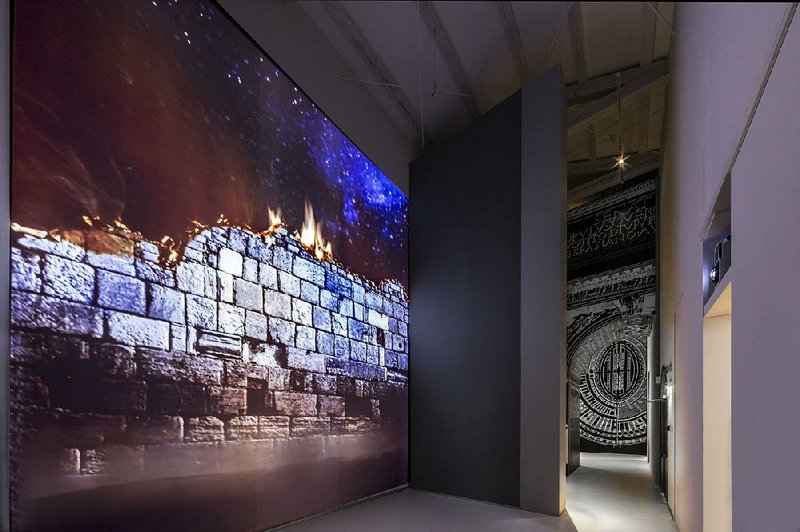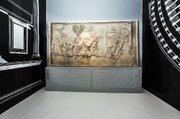Ready for a quick history lesson?
About 1,952 years ago, Rome sacked Jerusalem. Its soldiers carried off the treasures of the temple and thousands of Jews. The money and slave labor were then used to build a gigantic amphitheater you've probably heard of, called the Colosseum.
So there's no denying that Jews have been in Italy for a very, very long time. It's the most ancient community of Jews in the Western world, one that has withstood centuries of sorrow and tsoris while producing some of the nation's most important thinkers and writers.
And it's a topic that's the center of attention at the National Museum of Italian Judaism and the Shoah.
To explain the museum's mission, director Simonetta Della Seta posed a question: How is this museum different from all other Jewish museums?
For starters, instead of calling the National Museum of Italian Judaism and the Shoah a Jewish museum, it's "a national museum dedicated to Jews," Della Seta said. The museum exists because of a 2003 Italian law calling for the creation of an institutional space to teach about the Holocaust, and its mandate was soon expanded to cover all aspects of Italian Jewish life. Della Seta, an academic, journalist and diplomat who comes from a family of Holocaust survivors, is just as adamant that the museum is not a memorial. "If you're going to speak about Jews as dead people, it's not me," she said. "Items under glass is not me."
So it's fortunate that the museum is not organized around any sort of collection, Della Seta said, and can start with a narrative thread, then solicit loans to help tell those stories. "Italy is crowded with documents and objects," she said. "For the first time, we're asking, 'What do we have?'"
The museum is not even remotely close to being finished. Architectural plans call for five additional adjoining glass buildings -- representing the five books of the Torah -- that will eventually hold an auditorium, restaurant, archive, educational spaces and a youth wing. None of them has been built yet.
That didn't stop the museum from opening late last year in Ferrara, Italy, a gorgeously green city about 70 miles south of Venice. The UNESCO World Heritage site -- renowned for its medieval and Renaissance architecture-- has also been a vital center of Jewish life in Italy for 1,000 years or so, most notably during the reign of the House of Este, whose leaders encouraged Jews to settle there in the aftermath of the Spanish Inquisition. (Della Seta recounted the story of Gracia Mendes Nasi, a wealthy entrepreneur who pretended to be a Catholic while living in Lisbon, Antwerp and Venice. It wasn't until she moved to Ferrara in 1549 that she was able to practice Judaism openly.)
As in the rest of Italy, Ferrara eventually became less welcoming and forced its Jewish residents into a ghetto. Later, during the Nazi occupation, Jews were kept at the city's prison before being delivered to concentration camps.
That same prison, which was put out of commission in the 1990s, is where you'll now find the museum. Its debut exhibit, "Jews, an Italian Story: The First Thousand Years," is on display in what was the men's quarters. The crumbling building that housed female prisoners has been razed to make space for the museum's future expansion. In the meantime, it's the "Garden of Questions," an inviting labyrinth of herbs, that walks visitors through an explanation of Jewish dietary laws.
But first, the multimedia show "Through the Eyes of Italian Jews" -- showing now through September -- promises "2,200 years of Jewish history and culture in 24 minutes." The film, shown with narration alternating between Italian and English, relies on paintings, texts and photos to deliver a condensed crash course. It's also a reminder of all of the material the museum can tackle in the coming years. Next up, in 2019, will be an exhibit focused on Jews in the Renaissance.
There are objects such as the 1470 print of a book by historian Flavius Josephus, whose writings during the 1st century offer much of what we know about Jewish life from the time.
In another room is the epitaph of a 25-year-old Jewish woman, Claudia Aster, that reveals she was born in Jerusalem and brought to Italy as a slave. On loan from the National Archaeological Museum of Naples, it's a prime example of the kind of artifact that Della Seta said she expected will find more appreciation in this setting. "Here, there's context," she said, with a video evoking the burning of the temple on one side and a reproduction of Rome's Arch of Titus (which depicts the looting of the temple) on the other.
Although the museum only takes visitors up to the Middle Ages, the themes feel surprisingly modern. "This is a time of migration," said Della Seta, who insists that people today have much to learn from centuries of Jewish experience and resilience. And this knowledge, she adds, can serve as a tool to combat a recent rise in anti-Semitic sentiment.
The most visible effect of the museum's arrival so far has been on Ferrara, which is once again embracing its role as a hub of Italian Jewish culture, engaging in such activities as the hosting of the city's annual Jewish book festival this year, featuring a full day of author presentations.
Other than the museum itself, there's only one other site on tours of the city that's open to visitors: the Jewish Cemetery, which dates to at least 1626 and is still in use today. While rambling through the grass of the enormous property -- which extends back to the bike path along the city walls -- it's hard not to wonder what the people under those tombstones would think about the new museum.
But Della Seta spoke for them: "This is needed in Italy."
Religion on 07/14/2018


